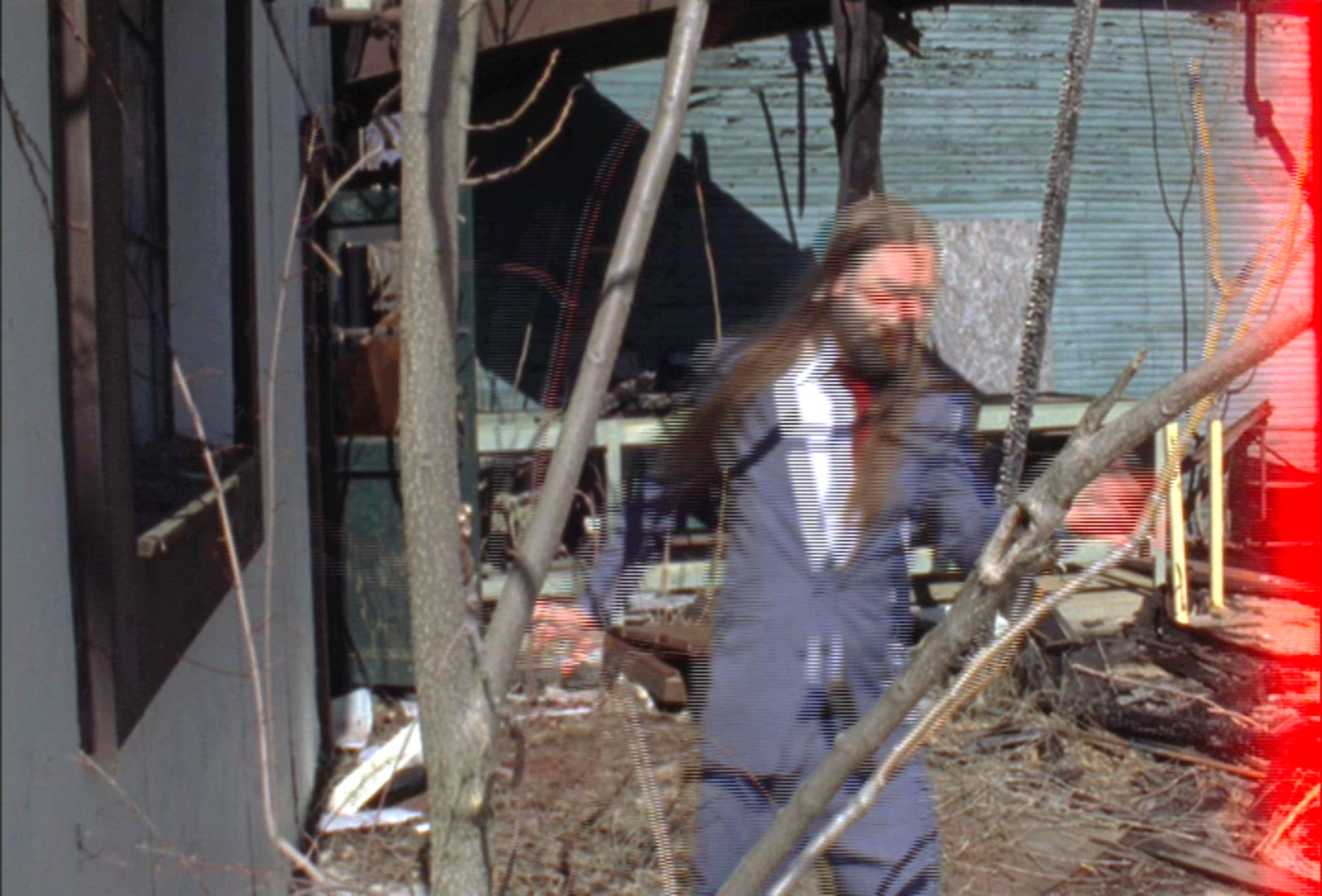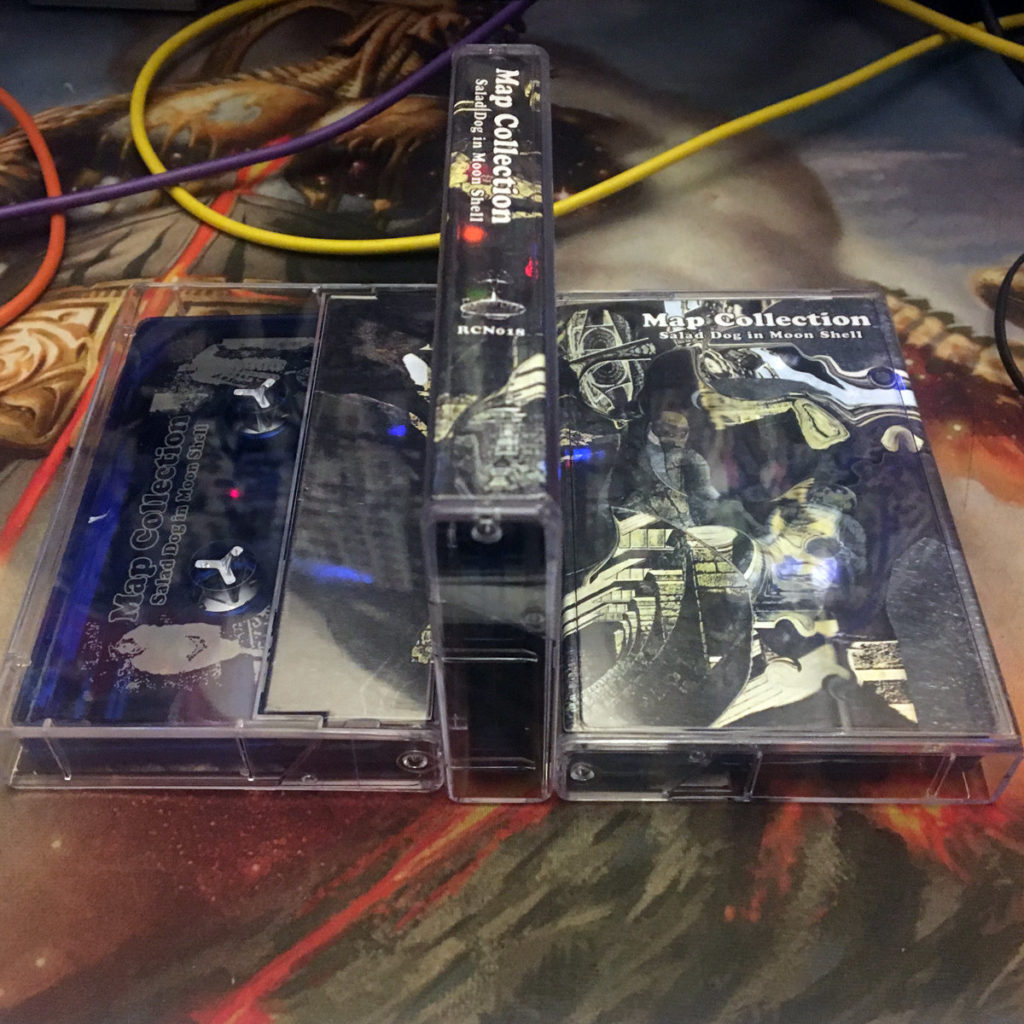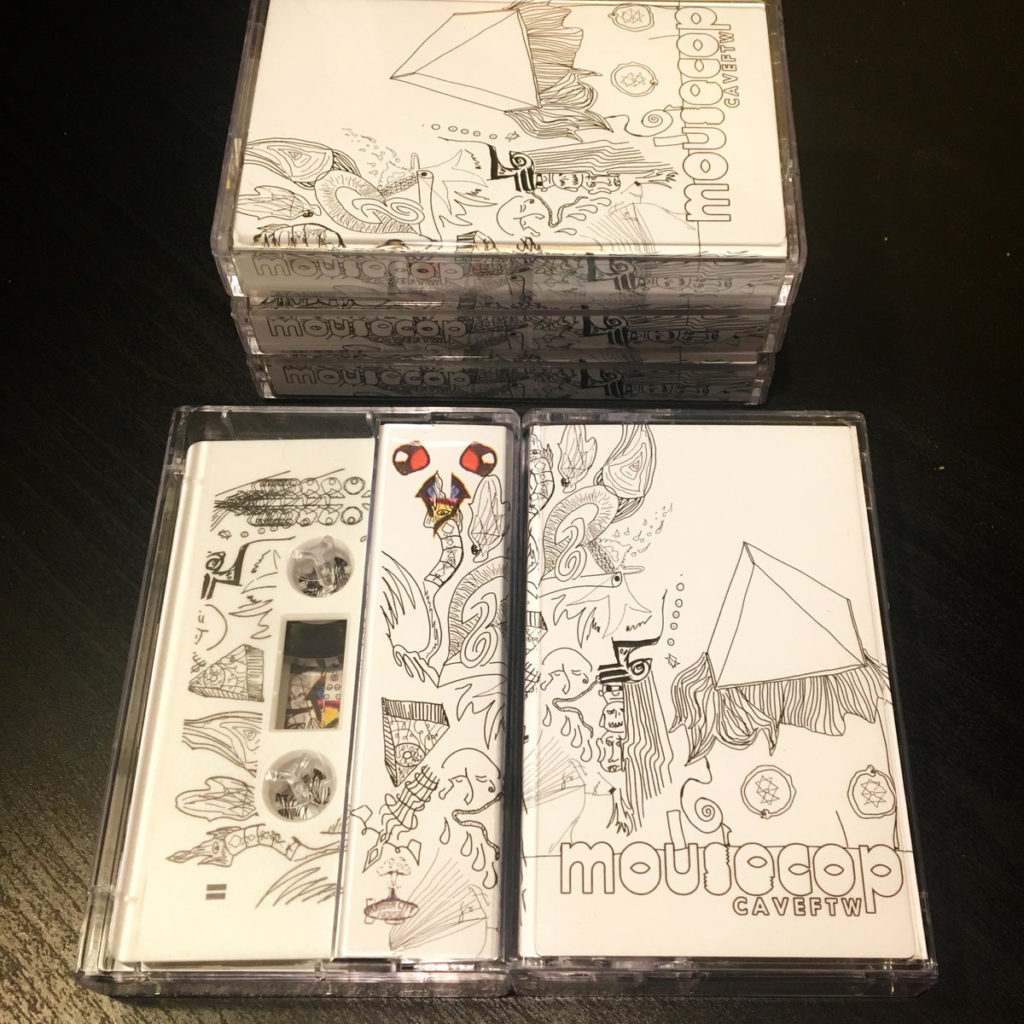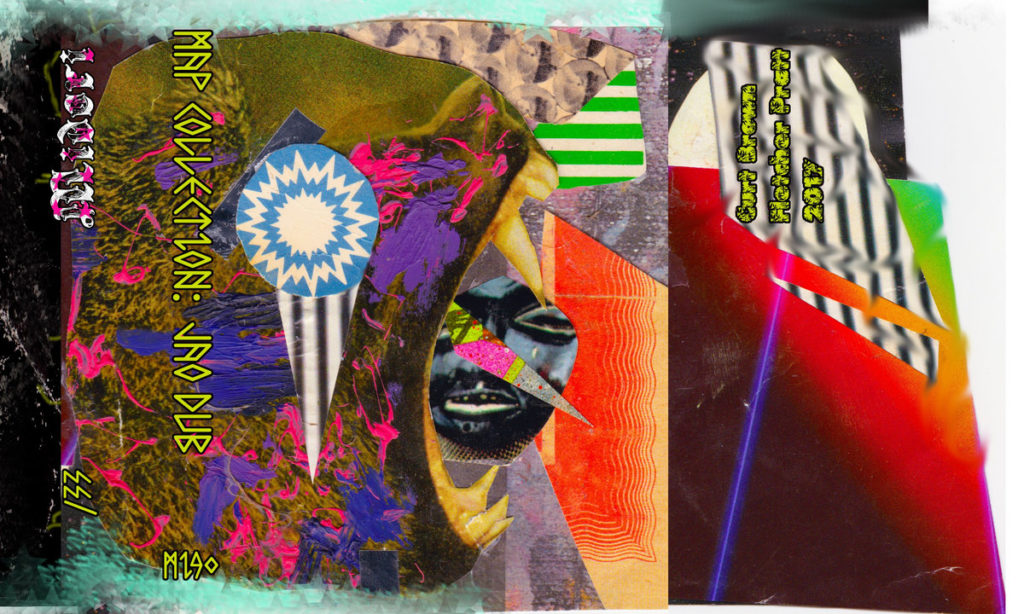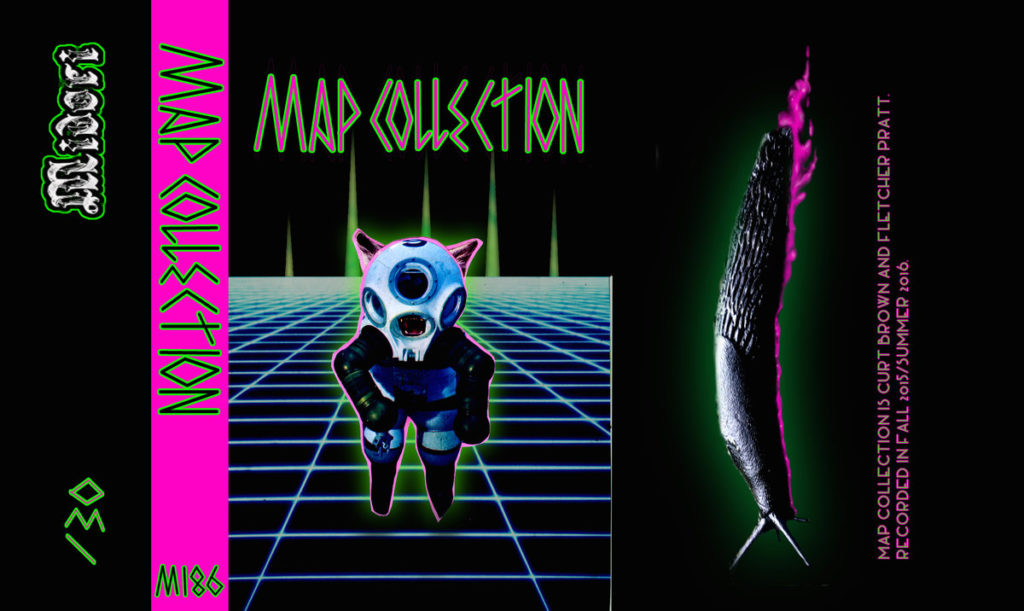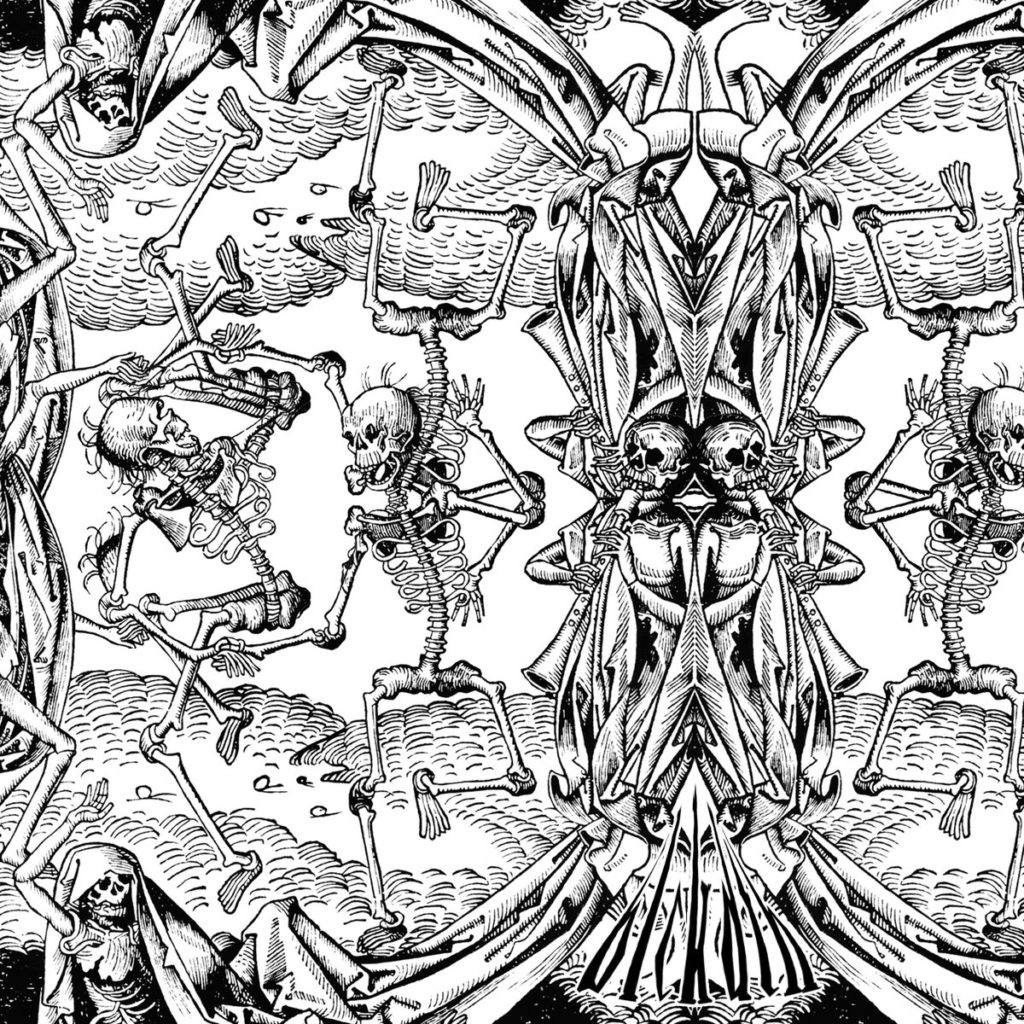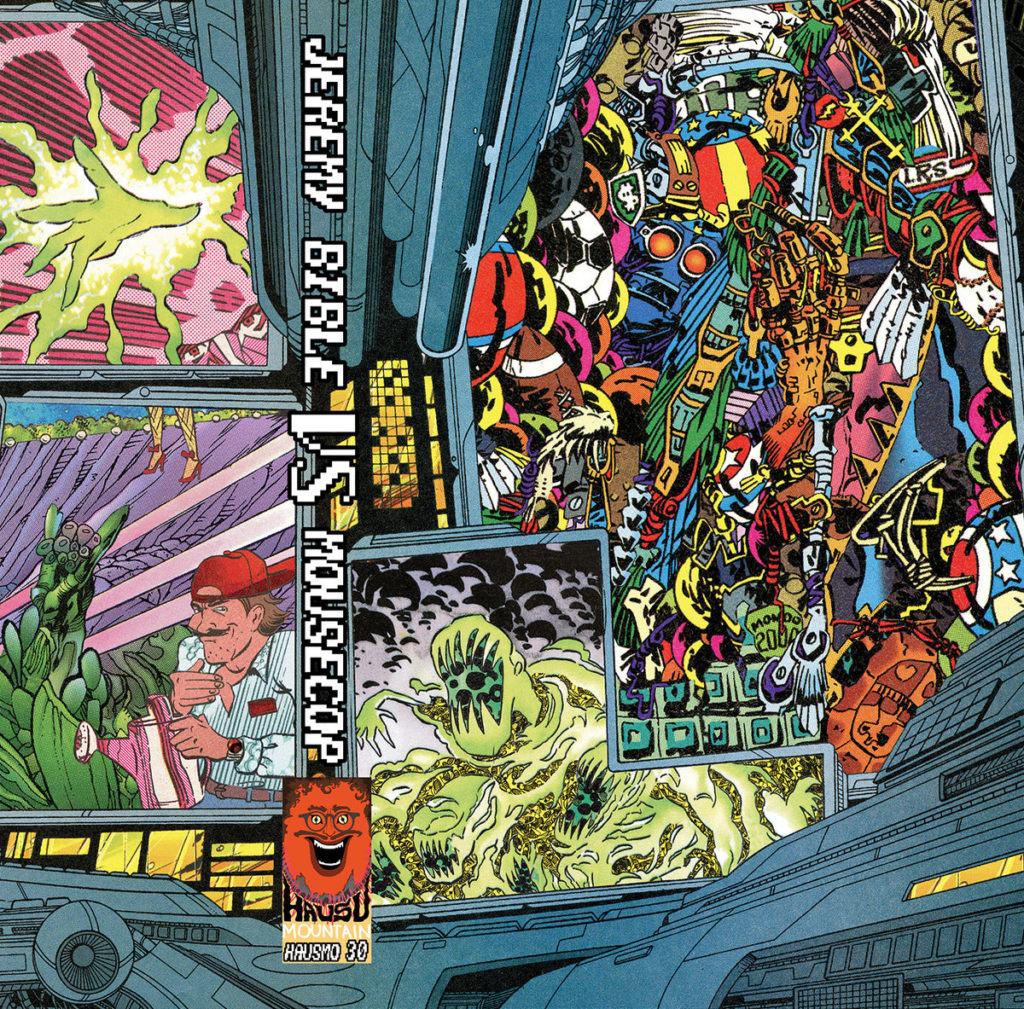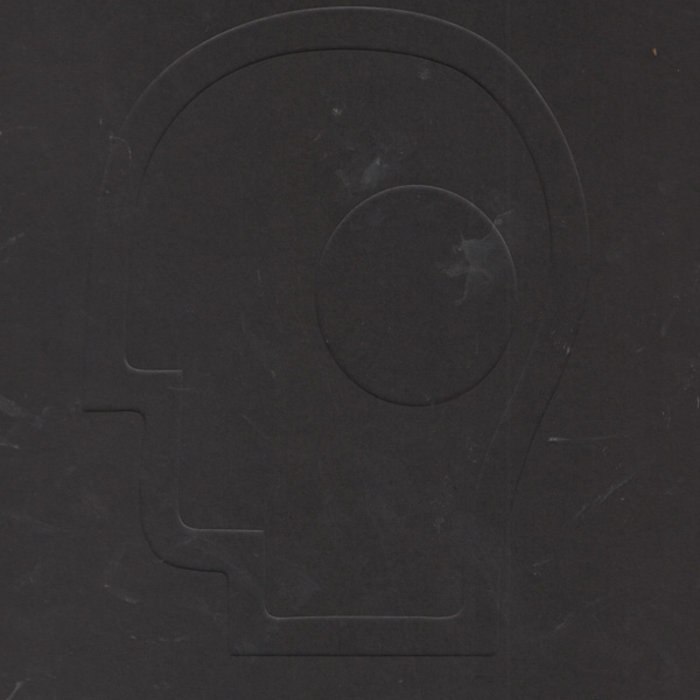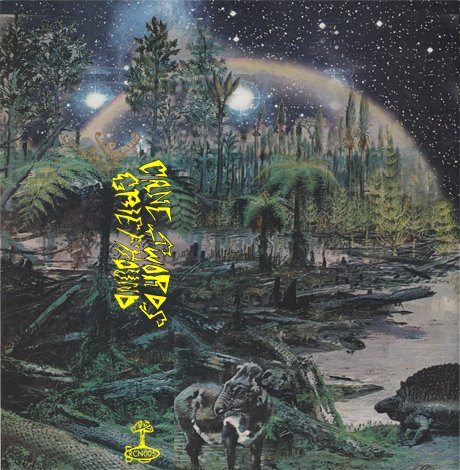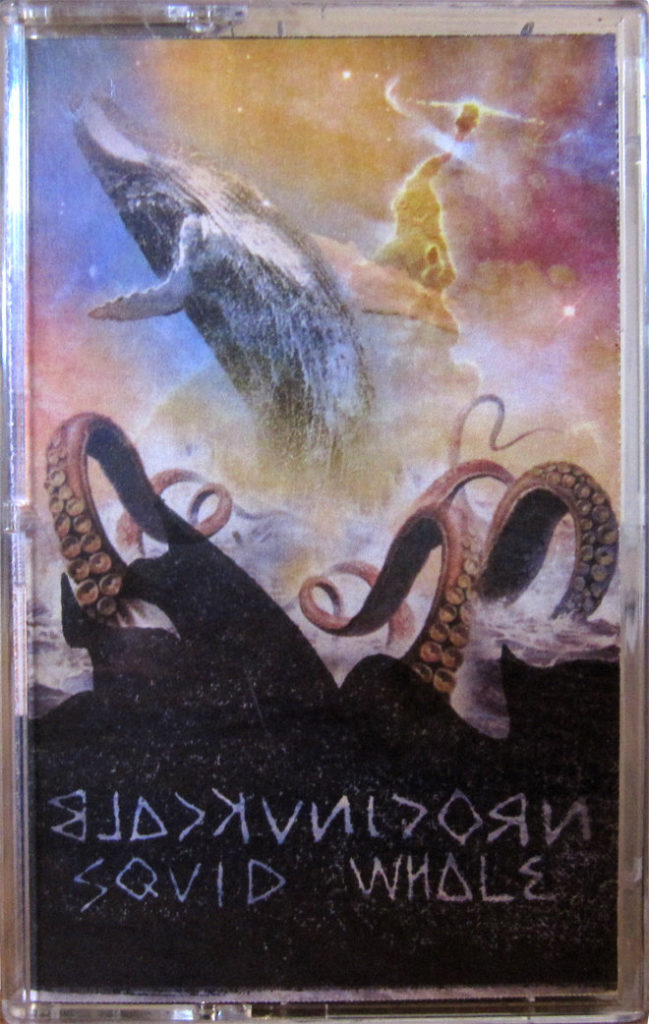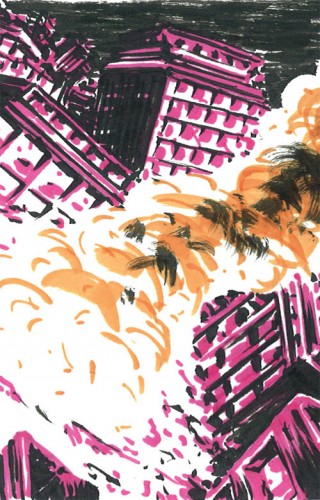Map Collection — Salad Dog in Moon Shell
Rubber City Noise, 2019
Forget dueling synths, Oakland supergroup*, Map Collection (Curt Brown and Fletcher Pratt), has concocted a four way meta-brawl here between electronic sub-genres with “Salad Dog In Moon Shell”, and it is no less than a vertical-listening strongarm, an impressionistic pitting of old school techno arpeggiations against industrial beats & textures, of modular synth tweakery against dirty drones, all of these disciplines simultaneously thrust into a rusty shark tank, and every single goddamn one of them allergic to any common pulse or cycle.
The achieved mood is a relentlessly chaotic series of claustrophobic dance floor meltdowns and lost-in-Joshua-Tree-and-my-flashlight-is-now-dead sprawlings of shadowy figures and shifting horizons. Probably not so hot for studying, but brilliant for losing your mind! — Jacob An Kittenplan, Cassette Gods
“Salad Dog in Moon Shell” finds Map Collective going off the … er … map (am I allowed to do that?) on a conceptual adventure that makes as much sense as a Vonnegut sonnet run through fragmenting software and spliced together via MS Paint. Which means, of course, that “Salad Dog in Moon Shell” is essentially a vision quest laser focused on discovering the cockeyed realities beyond the fringes of the average and everyday. Its creators, scene dreamers Fletcher Pratt and Curt Brown (gotta love that Black Unicorn!), upend expectation by enforcing the acceptance of the unusual upon the unsuspecting. I could’ve probably just said “dream logic” and been done with it. But where’s the fun in brevity? The software and synth jockeys pepper your perceptions with rancid electronics disguised as dub and electro smears, but in reality these noxious concoctions fizzle and pop and blurt and dribble and pulse and ping, disregarding genre as much as convention. Still, the whole thing is incredibly listenable in a broken and malfunctioning half-speed techno sort of way, and if it’s easier for you to grab on to that kind of description, then be my guest. I’m not gonna tell anybody. The point is for you to let “Salad Dog in a Moon Shell” get its hooks in you, because once it does and once you align your mind to it, it’ll let you in on its inverted secrets, which, take it from me, are worth knowing. Yeah, once “Salad Dog in a Moon Shell” has its hooks in you, it has them in you for good. And that’s OK. — Ryan Masteller, Tabs Out
Mousecop — CAVEFTW
Rubber City Noise, 2018
Mousecop’s actually a duo . . . made up of RCN alums Joshua Maxon Novak and J. Curtis Brown Jr., and their live performance captured to this very tape is at once haunting and squeamish, a collab cooked too long in a witch’s cauldron. It bubbles over and crusts the sides of the crockery, filling cracks in the stoneware and scoring the bottom of the pot. And that’s what RCN is all about: letting Mousecops be Mousecops, allowing their strange concoctions to fill the ears and the airwaves and the magnetic tapes, to give misfits like Novak and Brown a chance to spread their creative wings and fly as close to the sun as they want, disintegration be damned. And that’s what “CAVEFTW” sort of is – music disintegrated by the sun. — Ryan Masteller, Tabs Out
Map Collection — Jao Dub
Midori Records, 2017
Do you remember the episode of Star Trek: TNG when Fletcher Pratt and Curt Brown randomly beamed aboard Enterprise, interrupting the recording of a Captain’s Log? It’s an extremely rare episode titled “Jao Dub” that aired during season 8 or 9… Maybe 10? Known by a superfan (ie: me) as the one where Picard mumbles “oh shit” 11 times, it begins with Starfleet investigating what they foolishly confuse as distress signals from a small Class M planet nearby. After tracking down the curdling cry for help the crew scans the planet’s life signals, when *POOF* Pratt & Brown appear on the bridge, startling poor Picard who spills his tea, Earl Grey, hot all over his uniform. Before Worf can even attempt to neutralize the situation, the duo takes over command of the ship . . . Anyone familiar and smitten with Pratt and/or Brown’s various works (alone or in pairs) will sink right into Map Collection. “Jao Dub” is krauty sometimes, peculiar most of the time, and always confusingly satisfying. It’s no wonder why Gene Roddenberry hand picked them himself for the episode. No strangers to the off-brand wing of kosmiche dub stylings and synthesizer wrangling . . . I’d bet even Data would vibe out and nod along to sections, which is a pretty big deal.” — Mike Haley, Tabs Out
Synth, tape and various ways of sabotaging sound are on display here. The dub quality is perhaps outweighed by the goofily active approach to instrumental diddling. These guys almost sound like they’re cartoon animals or something: Goofy Meets Pluto Uptown With Big Shoes That Bleep & Everything.— Byron Coley, The Wire
Map Collection — Map Collection
Midori Records, 2016
Map Collection’s debut album is a minimalists’ psychedelic journey, conjured up by two cooperative (as opposed to dueling) modular synthesizers. Pretty much any blip & bloop you’ve ever dreamed of hearing in an office space, roar or hum from shipping warehouse, or space-echo-as-proof-of-distant-realities on the learning channel has been recreated by here in real time, looped, & fed into this cascading abyss of an hour long sonic ride. At times soothing ambient, at others noxiously chaotic, it’s a good headphone meditation, and a fanfuckingtastic headfuck in juxtaposition to a long walk in the wilderness. — Jacob An Kittenplan, Cassette Gods
blckdth — blckdth
Rubber City Noise, 2016
Two of the guys from Fire Death, plus another Ohio ex-pat now based in Oakland, California, equals this noisy new free music trio. Like Fire Death the feel of the stuff recalls some of John Olson’s more jazzoid projects. This means it retains a certain black metal/noise-grub quality that no number of bowties will mitigate. Not that these guys wear bowties. The instrumental line-up — drums, synth, bass clarinet/guitar — is bodaciously odd, and the playing is inventive and fleet. — Byron Coley, The Wire
Black Unicorn — Traced Landscapes
Field Hymns, 2014
Trance inducing, retro synthed out 8-bit landscapes come in and out of focus. One minute pulsing delicately, while buzzing melodies cut through the atmospherics the next. Tracks are focused squarely upon one idea, and that singularity holds time in place for just a little while before it’s gone, only to be replaced by the next hypnotic transcendence. . . . Black Unicorn is able to create the kind of sonic space that, in some pretty amazing ways, completely shifts our temporal perceptions. There are also songs like “Trans-Dimensional Railway” that pay due to Kraftwerk. The kraut-rock, electro pulse is definitely there, even floating there in the background after everything around it completely falls apart, leaving us with the sensation of temporarily floating through space. It’s as though the ground has been pulled completely out from under us and instead of falling we float off into the night sky. Pretty interesting way to have temporal considerations create the divisions between sections of a song. — Quartertonality
Black Unicorn is the solo venture of Curt Brown, who some call the Hans-Joachim Roedelius of Akron, Ohio. (I’d like to meet the people other than me who do that, actually.) . . . Brown’s synth excursions (and let’s face it, you can’t call them anything but excursions) are best experienced with high-tech noise-cancelling headphones, the bigger the better, so if you look like a 1980s helicopter pilot while listening, you’ve got the ideal situation going on. There’s no better way to chill out than with the opening couplet of “Lowland Observatory” and “Cosmonoctambulant” (and no, I will not type that again), trippy interstellar passages that tie new age, ambient, and Kosmische together to rip open a new dimensional rift in the spacetime continuum. . . . The rest of the album oscillates between the utterly magnificent ambience of Brown’s planetarium-gazing synth sculptures and more kinetic Tangerine Dream–inspired passages. It’s pretty much what the 1970s German experimental musician in me needs on occasion – let’s face it, a lot of occasions. Some artists in this genre suffer by disappearing up their own wormholes, creating cold, uninspired and same-y records with no intention of drawing in the listener. With Traced Landscapes, Brown as Black Unicorn has transcended the norm with a gorgeous, at times glorious, release. — Critical Masses
Sometimes there’s softly throbbing motorik synth loops that balance themselves like a spinning gyroscope, and sometimes seismic waves of sounds gently breathe an icy breath into the tape’s majestic life force. It’s pretty and twinkling and expansive and cosmic and celestial — all those things that make the great synthesists great these days while retaining its own unique stamp on things that should give it a calling card of sorts for future releases (as all the great ones have). Here’s hoping and looking forward to what becomes of the mythical beast and its beatific beauty. — Tiny Mix Tapes
Traced Landscapes presents forty-one cosmic minutes of deep synthesizer explorations piloted by Akron, Ohio-based Curt Brown (Cane Swords, Rubber City Noise) under the Black Unicorn name—imagine some freewheeling modern-day spawn of Tangerine Dream and Cluster and you’re on the right track. Generated from analogue and digital synthesizers, sequencers, and effects, Brown’s sunblinded material is very much in the tradition but pleasurable nonetheless, especially when he generally eschews noisemaking for tracks that are melodious and harmonious in equal measure. As soothing as certain tracks are, others veer into more turbulent corners of the galaxy. . . . Synthesizer music fiends with an insatiable appetite for space drones and interplanetary explorations should find much to admire about Traced Landscapes. — Textura
The music of the Akron, OH synth shapeshifter Curt Brown, a.k.a. Black Unicorn follows the footsteps of the ultimate stars of the fertile Ohio experimental ground, Emeralds with the spacey, synth-based compositions that expand on the original kosmische ideas. While I already heard him in 2011 through his tape Squid and Whale, at the time it slipped just a little past under my radar as the sound was raw and monumentaL . . . Black Unicorn is back with a new album, this time from Field Hymns, named Traced Landscapes. Here, Brown is ready with a much more honed and personified sound that sounds like the rawer, earlier moments of Tangerine Dream or the mind-bending analog electronics of the Radiophonic Workshop. These landscapes might be traced, but they surely are traced straight from the minds of the best. Solid and trippy! — Weed Temple
Field Hymns describes the album as “the law of correspondence seen from the rear view mirror of a departing space shuttle,” and though much of the album is composed of floating vignettes, these and others still incorporate the kinetic energy that the label invokes; subtle, like the slow arcs of a spacecraft tunneling at an angle through tidal forces. Though its name implies sketches and likens its songs to the representation of terrestrial spaces, Traced Landscapes can still seem to exist as much in the dance of pulsating energy I imagine is best observed from within a clear patch of deep space. In lieu of recourse to whatever mode of interstellar conveyance you prefer, grab the cassette from Field Hymns. — Dwight Pavlovic, Decoder Magazine
Jeremy Bible Vs. Mousecop
Hausu Mountain, 2014
From Jeremy Bible (Experimedia founder), Curt Brown and Josh Novak (founders of the Rubber City Noise collective / label) who play together as Mousecop, this is definitely one of the most enjoyable tape releases I’ve heard this year. Incredibly rich analog synths and semi-ethnic percussion and folk recordings are right up my alley, and the field recordings have a depth and warmth often lacking in music these days (I’m guessing they were captured on an actual tape recorder). Look forward to the latter half of Side 2 (”Initiation Well”), which is significantly more aggressive and harsh than the rest of the album. — Yeezus Walk With Me
As such, “Elegy Fr Baxter Stockman (Compassion Fr The Insects),” the A-side of a collaborative tape by Experimedia head Jeremy Bible and Akron-based duo Mousecop (Curt Brown and Joshua Novak of Rubber City Noise), is a nice reminder that, while there’s no excuse for Stockman’s evil-doing, empathy is as much an option as the interdimensional banishment that ended most Stockman-centric episodes. The elegy itself, which lurches between melancholic dirge, uncanny sound collage, and squealing noise, is a fittingly delirious memoriam for a sad cartoon character and just more evidence that the Midwest is fertile ground for some of the most free contemporary music around.— Joseph Ocón, AdHoc
Featured on Tabs Out Episode #67
Cane Swords — Temple Swords
Field Hymns, 2014
4 Stars — Cane Swords go beyond technological singularity as these synth composers blend the machine and your thought patterns into one. Akron, Ohio seems like as appropriate a geographical location as any to extrapolate harmony out of hardwires . . . Consisting of Curt Brown and Karl Vondran, the two combine textures into a single point of concentration that not so much burns like a laser or a specific instance as it does a memory. Four songs in around 40 minutes, your only complaint should be that this album needs to be longer. You become hypnotized by its electronic gaze as the sound flows in and out of your consciousness . . . Maybe this should have been soundtrack for a Painlevé film instead of Yo La Tengo, that is if Painlevé was an astrophysicist trying to extrapolate the mysteries of the universe. Despite its illusion of time, plan to get lost in Temple Swords sound drift. Meditate on the duo’s lucid soundscapes and by all means, don’t doubt for a second that this is one of ambient’s wonderful achievements. — Andrew Duncan, Selective Memory
Cane Swords also create music that breaks free from music’s traditional treating of temporality, but they are doing so in completely the opposite way. Where once there was a homogenous landscape that created hypnotic trances, there is now an ever changing and intricately woven fabric of sounds that whirl in and out of range. Much more spacey, ethereal and in a lot of ways, kind of intense. Recommended if you like Morton Subotnick . . . Tape composition practices are given an updated process, creating similar highly descriptive sound collages. . . . They do also have their darker, more ambient moments. Slower development across a long form composition, such as the “Telegraph One” and “Telegraph Two” suites, take a bit of a different approach to sound collage, stripping away some material to create a more homogenous sound. Overall the entire tape is full of some pretty enchanting stuff. — Quartertonality
Black Unicorn — Rediscovering Infinity
Deep Distance, 2012
I believe this is the first vinyl offering from Ohio’s Black Unicorn after a slew of killer tapes. “Rediscovering Infinity” is a tangled web of extrasolar exploration. With the short and on point opening slab of “Temporal Immensities,” you’re taken straight to the docking station and shoved through the airlock with nothing more than whispered promises of eventual return. Smothered rhythms lay the bedrock for a dizzying array of synthesizers to weave past, leaving soaring melodies in their wake. . . . Ambient abstraction plays a vital role as well, adding circuit-fried texture to these complex aural clusters that fill the deep sky. Layers of sequenced tones are fired rapidly, puncuated by scorched leads that cut through the dark matter on the evocatively-titled “Trans-Dimensional Railway.” At this point, you’re already on one hell of a ride. But the flipside is where the magic antes up to a whole new level. With a buried-but-still-booming 4/4 bassline underneath a river of murky electronics, “Celetal Supersanity” is deliciously grimey and relentlessly cerebral. It eventually breaks down and sinks to the bottom of an interplanetary ocean and that’s where album closer, “Whale,” rises for one last shot at the stars. It’s tense and dynamic, building up into a frenzy until it just kind of gently fades out into nothingness. “Rediscovering Infinity” is an absolute blast, showing just how on top of their game the criminally underrated Black Unicorn really are. Recommended. — Brad Rose, Experimedia
Cane Swords / Griefhound — Split
Rubber City Noise, 2011
Let me begin by saying that, if it’s a tape released by Northeastern Ohio-masterminds Rubber City Noise, then it has already got my fullest recommendation and support. With the few releases that they have delivered this year, RCN has displayed such an intense care for aesthetic, design, packaging, and production that it seems downright antagonistic not to support them. Now, following last month’s excellent Black Unicorn tape, RCN has shifted their sights from the deep sea to outer space on this time-warping split between synth demons Cane Swords and swamp sludgers Griefhounds. Needless to say, both sides are absolutely mental and totally captivating. It’s powerful and crucial stuff and just another reason why Rubber City Noise is killing it in 2011. — Zen Effects
/approaching disgust/
/cave trolls versus space wizards/
/degenerate beats/ — Justin Snow, Anti-Gravity Bunny Haiku Review
#16 on KZSU Stanford’s Top Tapes of 2011
Featured on The Wire’s Sleeves Received.
Akron, Ohio duo Cane Swords deal in fractured synthesizer textures, the kinds that build on the darker hues of early electronic pioneers Morton Subotnick and Raymond Scott. Rather than watery new age sounds, we get desolate, almost metallic scraping and pinching electronics — an overall struggle revealed through modular synthesis. — Keith Rankin, Tiny Mix Tapes
The Cane Swords side is totally killer, just absolutely great outer-space synth exploration. It feels like a bunch of different alien crafts coming at you at the same time. . . . The Griefhound side takes a while to get going, but then it tears into some lo-fi sludge metal. — Foxy Digitalis
It is easy to get lost in this monstrous split . . . both projects offer a disorienting, mapless take on their respective genres, each using different mediums, both ending up comparatively heavy. . . . [Ohio is] “connected” with a common mission: [to] make the “pure” electronic sound, free of annoying niceties or elegant sound effects in favor of monumental, sometimes outright harsh walls of sound. Cane Swords begin with a nearly tectonic, infrasonic rumble which later transforms into an image of a wasteland: raw, coarse sonic textures rub each other accompanied with cold, seemingly infinite pulsations. . . . If Cane Swords decided to assault the listener with synthesizers, Griefhound decided to do the same with guitars. The appropriately named “Churchburner” begins with distorted sludge riffs, first droning relentlessly in the vein of genre’s classics, such as Sunn O))) or Boris at their earliest . . . the first track is just a preparation for the grand jam: the 20-minute long monolith of “Thorns”, which more sludgy evil overloading the amps with a slow, open-ended jams filled with satanic loops and freestyle drumming. — Jakub Adamek, Weed Temple
Black Unicorn — Squid & Whale
Rubber City Noise, 2011
Primitive, old-school electronica brings to mind Jean Michel Jarre, Vangelis, Kraftwerk and other pioneers of their kind. At the same time, a dark current seems to flow through the robotic, analog rhythms, which are amateurish and soulful at the same time. The music becomes threatening, bringing forth a threat long forgotten, but once prevalent in popular culture as seen in films such as Blade Runner or Tron. The nostalgia for more innocent times, generates dreamy but thoughtful synth melodies, reverberating beats, which draw the listener in a world where magic is still possible. Highly recommended for anyone in love with early ’80s electronic music. — The Silent Ballet
Half of the Ohio dream-team known as Cane Swords, Black Unicorn actually beat The Emeralds at their own game. Breezy (almost New Age-ist) electronics that still somehow manage to hold my interest. Who’d’ve thunk it? — Byron Coley, The Wire
It’s a record of layered hardware synths: some old, some new. The sounds roll on top of each other with a belief in ‘real-time’ recordings. The sheer vibrancy within the minimal structures is astonishing. . . . the instruments are employed to create a sense of lighthearted futurism — think a beta soundtrack for a 16-bit Star Fox. As with the music of his peers, the ostensible limits of the machines provide a platform for endless experimentation and novel creation. — Samuel Breen, Clash Magazine
Layering oscillating electronic patterns over deep-sea drone, Black Unicorn has fucking outdone itself. The musical narrative of a battle between two oceanic collosi; I was initially expecting some hokey, dramatic synth bullshit. What I got completely blew me away. A masterfully crafted and theatrical composition, Squid and Whale is required listening. Fuckin’ go get it. — Geräuschkrieg!
Fresh off a red-hot CD-r debut, Black Unicorn (aka half of Cane Swords) is back with a total burner, this time presented on magnetic tape. “Squid And Whale” is here to fuel your blade running fantasies. Soaring arpeggios, deep sea drones, claustrophobic headfuckery, it’s all here. —OMGVinyl
For those of you who think that they just don’t make massive, thought-inducing, concept tapes like they used to, have I got the album for you. Following the intertwined activities of its titular beasts, Squid Whale swirls around with with awesome synth based melodic movements that totally bring the story to life. Even if you get too wrapped up in the music, you can follow the story along with a Spark Notes-esque summary generously printed in the tape’s packaging. Still, there is enough to enjoy here for those just looking to bliss out to a fantastic droning synth tape without worrying about the bigger picture. Enormous humpback recommendation! — Zen Effects
Cane Swords — Big Warmup in the Mouth of Eternity
Rubber City Noise, 2011
The very first release from RUBBER CITY NOISE, a bizarre tape of hypno synth noise by Cane Swords, aka Curt Brown & Karl Vorndran. These two dudes created spacey nightmares with a traditional smorgasbord of electronics, plus some hacked shit like a circuit bent Buddha Machine, handmade phaser, RCN Hello Kitty Ring Mod, and the requisite infinite blue light. Big Warmup In The Mouth Of Eternity is a fucking journey and a half. Layers upon layers of static & space dust, glitches & anti-matter. They build dense clouds of electro mist, raining ice crystals down through murky tumble drones, bubbling swamps of gamma rays, pulsars of technoise in a blazin hot swarm. It’s pure fucking chaos without relying on an ear-rupturing brain fuck. They wobble down a line of immersive bliss and sloppy malarkey, keeping you totally locked in, scanning for the brief moments of enlightenment. . . . Pillaging from the maelstroms in mid-century electronics and sci-fi soundtracks, Cane Swords take the current smear of synths and throw their own blend of insanity into the mix. Big Warmup is goddamn fantastic, an hour long disarray of non-abrasive synth noise that spits in your face and tells you to chill the fuck out. Honestly can’t wait to see what both this new label & band have coming up. RCN is gonna be a label to keep your hawkeye on, that’s for damn sure, because they’re packaging is sweet as hell and they do FREE DOWNLOADS of most of their releases, INCLUDING THIS ONE, so fucking GRAB. IT. — Justin Snow, Anti-Gravity Bunny
[Big Warmup] was a record I fell hard for and one that should have been in my top five of last year . . . a complex, immense record which contains everything I like about experimental music. I may be a prick for not posting earlier but you’d be a prick not to hear it. — Ducks Battle Satan
Featured on The Wire’s Sleeves Received Blog
# 16 on KZSU Stanford’s Top Tapes of 2011
